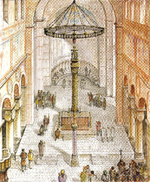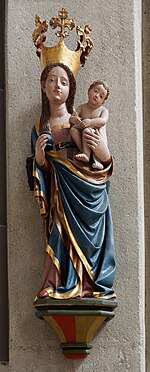Thousand-year Rose

The Thousand-year Rose (German: Tausendjähriger Rosenstock, literally: Thousand-year-old Rosebush), also known as the Rose of Hildesheim, grows on the apse of the Hildesheim Cathedral, a Catholic cathedral in Hildesheim, Germany, that is dedicated to the Assumption of Mary. The cathedral and the adjacent St. Michael's Church have been on the UNESCO list of World Heritage Sites since 1985.The rose that climbs on the wall of the cathedral's apse is believed to be the oldest living rose in the world. A wild dog rose (Rosa canina), it grows against the eastern apse of the cathedral, which is around 21 m (69 ft) high and 9 m (30 ft) wide. The rose bush reaches a height of around 10 m (33 ft) and documentation verifies its age at around 700 years. Slight variations arise in the tale of the establishment of the diocese by King Louis the Pious at Hildesheim in 815 but the rose bush is a common theme in all versions. The cathedral was destroyed by Allied bombers in 1945 during the Second World War, but the roots of the rose bush survived and it blossomed again among the ruins. According to legend, while the rose bush flourishes, Hildesheim will prosper.A poem about the rose was published in 1896. In the early twentieth century, after visiting the cathedral and seeing the rose, author Mabel Wagnalls was inspired to write a book, which went on to form the basis of a silent film.
Excerpt from the Wikipedia article Thousand-year Rose (License: CC BY-SA 3.0, Authors, Images).Thousand-year Rose
Krypta, Hildesheim Altstadt (Stadtmitte/Neustadt)
Geographical coordinates (GPS) Address External links Nearby Places Show on map
Geographical coordinates (GPS)
| Latitude | Longitude |
|---|---|
| N 52.149083333333 ° | E 9.9475555555556 ° |
Address
1000 jähriger Rosenstock
Krypta
31134 Hildesheim, Altstadt (Stadtmitte/Neustadt)
Lower Saxony, Germany
Open on Google Maps










